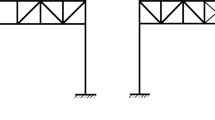Abstract
In current seismic design standards such as ASCE/SEI 7, three seismic load analysis methods are permitted to design structures, which are equivalent lateral force (ELF) procedure, modal response spectrum analysis (RSA), and response history analysis (RHA). The aim of this study was to conduct seismic loss estimation to investigate the impact of using ELF and RSA on the seismic loss. For this purpose, 4- and 12-story regular steel special moment frames (SMFs) were repeatedly designed using ELF and RSA. The expected annual losses for 4- and 12-story SMF buildings designed using the RSA were 30% and 23% higher than those of corresponding buildings designed using the ELF. The main cause of larger seismic loss in RSA buildings was attributed to lateral stiffness less than ELF buildings. More significant damage occurred in RSA buildings during frequent earthquakes, which was main contribution on the increase in the seismic loss.











Similar content being viewed by others
References
AISC. (2016a). Seismic provisions for structural steel Buildings. ANSI/ANSI 341-16. American Institute of Steel Construction.
AISC. (2016b). Prequalified connections for special and intermediate steel moment frames for seismic applications. ANSI/ANSI 358-16. American Institute of Steel Construction.
ASCE. (2017a). Minimum design loads for building and other structures. ASCE/SEI 7-16. American Society of Civil Engineers.
ASCE. (2017b). Seismic evaluation and retrofit of existing buildings. ASCE/SEI 41-17. American Society of Civil Engineers.
ATC. (2010). Modeling and acceptance criteria for seismic design and analysis of tall buildings. PEER/ATC 72-1. Pacific Earthquake Engineering Research Center/Applied Technology.
Bech, D., Tremayne, B., & Houston, J. (2015). Proposed changes to steel column evaluation criteria for existing buildings. In Improving the seismic performance of existing buildings and other structures 2015, pp. 255–272.
Burton, H. (2014). A rocking spine for enhanced seismic performance of concrete frames with infills. Doctoral dissertation, Ph. D. dissertation, Dept. of Civil and Environmental Engineering, Stanford Univ., Stanford, CA.
FEMA. (2009). Quantification of building seismic performance factors. FEMA P-695. Federal Emergency Management Agency.
FEMA. (2018a). Seismic performance assessment of buildings, volume 1—Methodology. FEMA P-58-1. Federal Emergency Management Agency.
FEMA. (2018b). Seismic performance assessment of buildings, volume 3.3 - supporting electronic materials and background documentation. FEMA P-58-3. Federal Emergency Management Agency.
FEMA. (2018c). Seismic performance assessment of buildings, volume 5 - expected seismic performance of code-conforming buildings. FEMA P-58-5. Federal Emergency Management Agency.
Gupta, A., & Krawinkler, H. (1999). Seismic demands for performance evaluation of steel moment resisting frame structures. Rep. No. 132. Stanford University, Stanford, CA: John A. Blume Earthquake Engineering Research Center.
Han, S. W., Moon, K. H., & Jung, J. (2014). Cyclic performance of welded unreinforced flange-welded web moment connections. Earthquake Spectra, 30, 1163–1181.
Han, S. W., & Kim, N. H. (2017). Permissible parameter ranges of access hole geometries for WUF-W connections. Earthquake Spectra, 33(2), 687–707.
Hwang, S. H., Elkady, A., Bardaweel, S. A., & Lignos, D. G. (2015). Earthquake loss assessment of steel frame buildings designed in highly seismic regions. In Proceedings of the 5th ECCOMAS Thematic Conference on Computational Methods in Structural Dynamics and Earthquake Engineering (COMPDYN 2015). Crete Island, Greece, pp. 1496–1512.
Ibarra, L.F., Medina, R.A., Krawinkler, H. (2005) Hysteretic models that incorporate strength and stiffness deterioration. Earthquake engineering andstructral dynamics, 34(12) 1489–1511. https://doi.org/10.1002/eqe.495.
Kim, T., & Han, S. W. (2021). Seismic collapse performance of steel special moment frames designed using different analysis methods. Earthquake Spectra, 37(2), 988–1012.
Lignos, D. G., & Krawinkler, H. (2011). Deterioration modeling of steel components in support of collapse prediction of steel moment frames under earthquake loading. Journal of Structural Engineering, 137(11), 1291–1302.
Lignos, D. G., Hartloper, A. R., Elkady, A., Deierlein, G. G., & Hamburger, R. (2019). Proposed updates to the ASCE 41 nonlinear modeling parameters for wide-flange steel columns in support of performance-based seismic engineering. Journal of Structural Engineering, 145(9), 04019083.
McKenna, F. (2011). OpenSees: A framework for earthquake engineering simulation. Computing in Science & Engineering, 13(4), 58–66.
Mitrani-Reiser, J. (2007). An ounce of prevention: Probabilistic loss estimation for performance-based earthquake engineering. Doctoral dissertation, California Institute of Technology.
Moon, K. H., Han, S. W., Lee, T. S., & Seok, S. W. (2012). Approximate MPA-based method for performing incremental dynamic analysis. Nonlinear Dynamics, 67(4), 2865–2888.
NEHRP. (2010). Evaluation of the FEMA P-695 methodology for quantification of building seismic performance factors. NIST GCR 10-917-8. NEHRP Consultants Joint Venture.
NEHRP. (2012). Tentative framework for development of advanced seismic design criteria for new buildings. NIST GCR 12-917-20. NEHRP Consultants Joint Venture.
Ramirez, C. M., & Miranda, E. (2012). Significance of residual drifts in building earthquake loss estimation. Earthquake Engineering & Structural Dynamics, 41(11), 1477–1493.
Ryan, K. L., Sayani, P. J., Dao, N. D., Abraik, E., & Baez, Y. M. (2010). Comparative life-cycle analysis of conventional and base-isolated theme buildings. In 9th US National & 10th Canadian Conference on Earthquake Engineering, Toronto, Canada.
Sattar, S. (2018). Evaluating the consistency between prescriptive and performance-based seismic design approaches for reinforced concrete moment frame buildings. Engineering Structures, 174, 919–931.
Speicher, M. S., & Harris, J. L., III. (2016). Collapse prevention seismic performance assessment of new eccentrically braced frames using ASCE 41. Engineering Structures, 117, 344–357.
Vamvatsikos, D., & Cornell, C. A. (2002). Incremental dynamic analysis. Earthquake Engineering & Structural Dynamics, 31, 491–514.
Zareian, F., & Medina, R. A. (2010). A practical method for proper modeling of structural damping in inelastic plane structural systems. Computers and Structures, 88, 45–53.
Acknowledgements
It is acknowledged that the research has been supported by grants from the National Research Foundation of Korea (NRF-2020R1A2C2010548 and NRF-2021R1A6A3A01087444).
Author information
Authors and Affiliations
Corresponding author
Additional information
Publisher's Note
Springer Nature remains neutral with regard to jurisdictional claims in published maps and institutional affiliations.
Rights and permissions
About this article
Cite this article
Kim, T., Han, S.W. Seismic Loss Estimation of Steel Special Moment Frames Designed According to Different Analysis Methods. Int J Steel Struct 22, 1623–1633 (2022). https://doi.org/10.1007/s13296-022-00633-y
Received:
Accepted:
Published:
Issue Date:
DOI: https://doi.org/10.1007/s13296-022-00633-y




